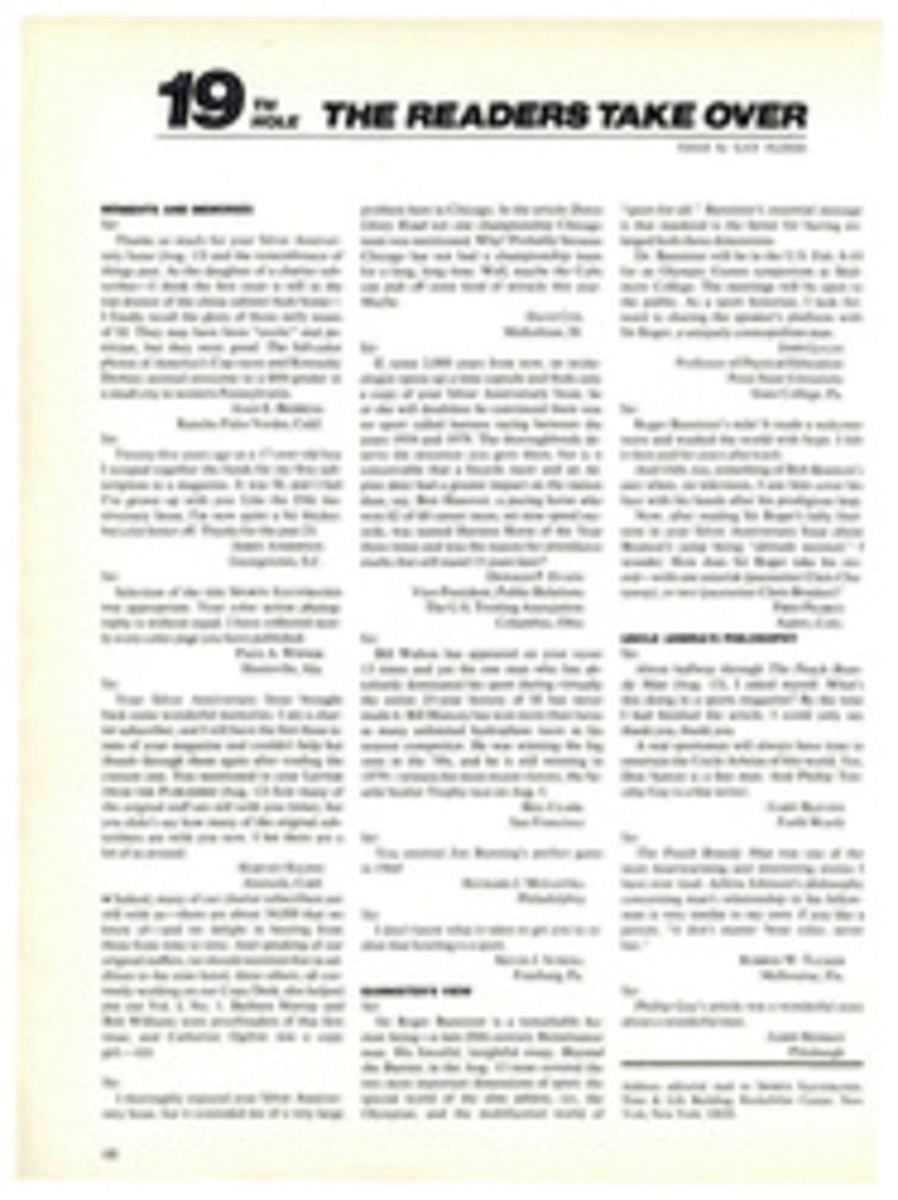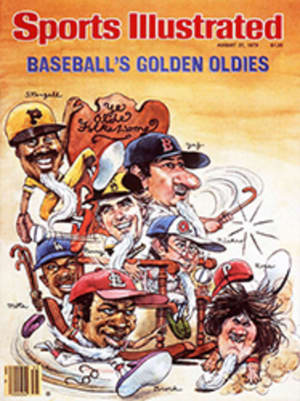
An ongoing fungoer
Ryan or Guidry? Rice or Parker? One of the axioms of baseball is that fans—and insiders, too—will forever argue over who is best at a particular skill. Best hitter, best pitcher, best peanut vendor. No claim of superiority is beyond dispute. Well, almost none. The sole exceptions are the superlatives bestowed on Jimmie Reese, a spry 74-year-old coach for the California Angels. Reese not only is the oldest man in a major league uniform, but he is also the world's greatest fungo hitter. There can be no debate on either point.
For the information of fans who never arrive at a game before the national anthem, fungoes are the balls a coach hits to fielders during pregame drills. The derivation of the term "fungo" is somewhat obscure. According to one explanation, it comes from an old game in which the hitter would yell, "One go, two go, fungoes." Whatever the source, White Sox Coach Bobby Winkles says that when it comes to fungoes, "Jimmie Reese is No. 1 and the rest of us are eighth, ninth and 10th." Minnesota Manager Gene Mauch adds, "He's got a swing any tournament golf pro would envy."
Mauch's praise helps explain how Reese once shot an 82 for 18 holes using only a fungo bat and a putter. In 1968, while coaching Seattle in the minors, Reese beat a golf pro in a test of accuracy. Standing at home plate, he stroked four out of 15 baseballs into a circle in centerfield with his bat, while the golfer dropped in two golf balls with a nine iron.
In another esoteric test, Reese won a bet from current Pirate skipper Chuck Tanner, when Tanner was the Seattle Rainiers' manager, by hitting a flagpole from 100 feet away on his first swing. But Reese's fungo skills have not always been employed so frivolously. Until 1972 he "pitched" batting practice in the minors with a fungo bat—and without a protective screen. "He hit strikes with 90% accuracy," says Cleveland Second Baseman Duane Kuiper. "That's better than most pitchers." Reese's mound career ended prematurely after a line drive whistled dangerously close to his head. "If that ball had hit me," recalls Reese with a shudder, "it would have sent me to the great beyond."
Reese broke into baseball in 1917 as a bat boy, a clear indication of destiny's call. The highlights of his playing career came as a Yankee rookie in 1930 when he hit .346 in 188 at bats and roomed with Babe Ruth. "I probably roomed with his bed more than with Babe," recalls Reese. "He had one of those unusual constitutions. He could stay up all night and still hit a ball 500 feet."
Since retiring as a player in 1938, Reese has banged out some two million short hoppers, towering pop-ups, long flies and sinking line drives—most of them with bats he makes in his workshop at home. That's right, Jimmie Reese, the game's premier fungo hitter, doesn't use a store-bought fungo bat. A wood-carver in his spare time, he fashions his own by splitting a regular bat through the middle with a band saw. "Tan oak doesn't crack or split as easily as the ash or poplar they use in the fungo bats today," explains Reese, "and mine is heavier. Normal fungo bats are 16 to 25 ounces; mine is 27 and has greater balance." Reese hits the ball with the rounded side and uses the flat surface to scoop up balls as the fielders throw them in to him. "Not having to bend down to pick up those balls has added two or three years to my career," he says. He also pops 80 vitamin pills daily and never lights the cigars he chomps.
For the most part, Reese has used the same fungo bat the last nine years, unlike other coaches, who go through at least three or four a season. But this one is not really his favorite. He almost lost that bat in 1967 when he made the mistake of lending it to a young player. Without Reese's knowledge, the player took the bat into the batting cage and—oh no!—broke it. Because of their light weight, fungo bats are easy to swing and control, but they cannot withstand the impact of a major league fastball. Reese was able to put the broken bat back together, and now he keeps it under lock and key.
Those coaches who aren't as particular as Reese obtain their fungo bats from the Hillerich and Bradsby Co. Some models are shaped like a slimmed-down version of a regular bat, others resemble a broomstick or have a thin handle with a bottle barrel.
For the past seven seasons Reese's fungo duties have been restricted largely to conditioning the Angel pitchers. Rather than make them suffer through monotonous wind sprints, as is the custom, Reese runs them backward, forward and to the side as he bangs out balls.
"Jimmie can stretch you out so that the ball just hits your glove," says Nolan Ryan, who named his second son Reese. "We've never been in better shape, and he's such a great man that our morale has been tremendous."
Watching Reese practice his craft is like attending a clinic. "If I want to hit grounders, I hit the ball while it's between my waist and knees," he says. "If I want to pop one straight up for a catcher to work on foul flies—and that's the toughest fungo to hit—I have to throw the ball over my head and come under it. And if I'm hitting flies to the outfielders, the ball is only slightly above my head so I can get distance. If you want line drives, it's out to the side so that you can strike it good."
Because Reese only hits to the pitchers, probably the best all-purpose fungo hitters today are Bobby Knoop, another Angel coach, and Dave Garcia, the manager of the Indians. "During spring training, I keep extending the fielders gradually so that they begin to realize how far they really can go," says Garcia. "But before a game I never try to cross up the infielder. I try to make him look good, give him a ball he can handle."
Like playing the oboe, fungo hitting is a difficult art, and not every coach masters it. The Yankees' Yogi Berra, for example, readily admits he's inept. He considers it a chore just to get the ball in the vicinity of the fielder, so he doesn't worry about such subtleties as speed and spin. "Yogi really is bad," confirms Yankee broadcaster and former teammate Phil Rizzuto. "He's broken his finger twice hitting fungoes."
Pitchers traditionally have been the best at hitting fly balls with fungo bats, probably because it gives them a chance to accomplish in practice what they can seldom do in a game: smash the ball a long way. As a result, they are the leading experts at busting balls over fences or into the stratosphere, altogether useless skills that Reese considers bastardizations of the art.
When it comes to muscle flexing, few players can jerk a ball as far or as high as journeymen relievers Joe Hoerner, who played from 1963 to 1975, and Ed Roebuck (1955-66). Both hit tape-measure shots in numerous parks, but they are best remembered for reaching the highest part of the Astrodome roof, the ultimate test in power fungo hitting.
When fungo hitters visit Houston they invariably try to reach the roof. Most fail. The only current player who can drive a fungo that high with any regularity is San Diego Reliever Rollie Fingers.
The fungo may have been as important in determining the height of the Astrodome as the calculations of any engineer. Roebuck recalls that during spring training in 1963 the late Dodger owner, Walter O'Malley, approached him early one morning with a challenge: Could Roebuck hit a fungo 200 feet straight up in the air? O'Malley wanted the information to assist in the design of the Dome. Certainly the pitcher was a logical choice for the experiment because he had once hit a ball out of the Los Angeles Coliseum, a prodigious shot that cost him a $75 fine. Roebuck told O'Malley he was up to the task, so that afternoon he and O'Malley took the field with a fungo, a bag of balls and various measuring devices. The rest is architectural history.
"Mr. O'Malley never told me how high the balls went," says Roebuck, "but they must've been close to 200 feet because a few days later, while I was sitting in the bullpen during a game, a bat boy delivered a sack stuffed with $75 in quarters." And, sure enough, the design for the Astrodome called for the roof to be 208 feet above the field at its highest point. Though the roof remains a favorite target of fun-loving fungoers, it has never been hit during a game.
For all its importance, fungo hitting remains an unappreciated phase of baseball. This circumstance is no doubt attributable to its tarnished reputation. The 1886 edition of Art of Batting warned ominously, "There's no worse habit for batsmen to indulge in than batting 'fungo' balls."
But there is no better habit for coaches who want to hone a player's defensive skills or whip him into shape.
PHOTO
Reese's homemade bat keeps pitchers hopping.

